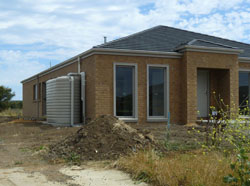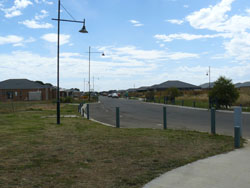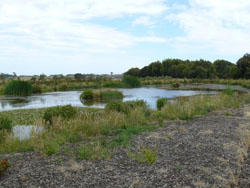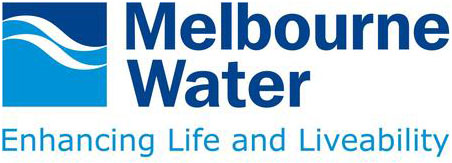resource library
Array
Rainwater tank on site

Houses nearing completion

Marrakai Wetland - stormwater storage and treatment
Roof Water Harvesting Project
Warrnambool City Council
Russells Creek Growth Corridor, North East Warrnambool, Victoria | Map:
Published: 26 March 2012
Project Overview
Wannon Water’s Roof Water Harvesting project takes established stormwater management technology and redefines it to help meet the growing water supply demand in the City of Warrnambool.
It is the first project of its kind in Australia and essentially involves the collection and diversion of roof runoff from houses within an estate. Roof runoff is diverted away from the surface stormwater system via a separate collector pipe. The separated roof water flows under gravity to the Wannon Water untreated water storage (Brierly Basin) via a new trunk pipeline where it mixes with other untreated water. Water from the storage is treated through the existing Warrnambool water treatment plant to produce drinking water for the City of Warrnambool.
Roof water is known to be generally cleaner than surface stormwater runoff i.e. contains less contaminants. As such, less treatment is required prior to reuse. This new source of raw water will increase the potential catchment for the City as well as mitigate the impacts of high volume storm flows on the waterways and creeks in the region.
The scheme has included the construction of 2250 m of trunk water mains and approximately 4400 m of smaller diameter collection mains within the new development area.
The size of the demonstration area changed through the life of the project from an initial 142 lot subdivision with retirement village to three subdivisions involving 273 lots. These lots are located in a growth corridor that will eventually grow to over 3000 lots and as such there is potential for the roof water harvesting scheme to be extended as development in the growth corridor continues.
Drivers and Objectives
To construct the required infrastructure allowing the catchment and treatment of roof water runoff to augment the local water supply as the residential community in Warrnambool grows.
To use this site as a pilot project and undertake monitoring and evaluation to allow other water authorities and councils to establish similar projects in applicable developments.
To use this demonstration project to identify risks and barriers to the concept and communicate any lessons learned.
Organisations
- Wannon Water (Project Initiator)
- Australian Government – Water for the Future (Funding Partner)
- Victorian Government – Stormwater and Urban Recycling Fund (Funding Partner)
- Cove Land Developments Pty Ltd (Developer)
- Warrnambool City Council (Responsible Council)
Project Outcomes
The virtual elimination of ongoing greenhouse gas emissions in delivering water to the storage.
Risk of contamination is minimised, with a sole body having management of the water (when compared to individual rain water tanks). Contamination is likely to be minor and treatable before distribution into the potable water network.
Wannon Water have developed a toolkit with information and resources including the ability to compare roof water harvesting with other sources of water supply and establish a net cost per megalitre, i.e. allowing direct comparisons.
Lessons Learnt
There are challenges with managing roof water harvesting, particularly the transfer of water from a local government authority to a water retailer. This project demonstrates how to overcome these challenges through working collaboratively between the key stakeholders.
The regulatory and cultural behaviours of the plumbing industry can be challenging as a number of domestic plumbers have installed house connections with a ‘business as usual approach’ and connected the roof downpipes into the regular stormwater system.
Costs to the Council and the development industry were minimised as less extensive flood management basins will be required to mitigate increased stormwater runoff as the catchment develops.
Infrastructure (capital) and recurrent (operational) costs are minimised as the scheme does not require extensive centralised systems.
Project Cost
The total cost of the project was $3.8M with $2M contributed by Federal and State funding.
In addition, it will cost approximately $3000 per new property to augment the drainage system and connect into the water supply system.
Timeframe
The initial phase of this project was completed in June 2010. The second phase of trunk infrastructure works was completed later in the year. New homes are connected as they are constructed over the coming years.
Contact
Clearwater: 03 9679 7835
